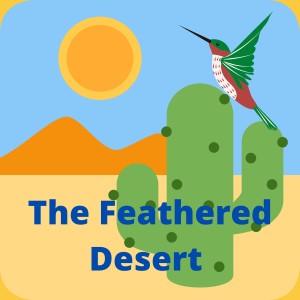
10.4K
Downloads
144
Episodes
Backyard bird feeding is one of the most enjoyable and rewarding hobbies on earth. Join Cheryl and Kiersten as they talk all about bird feeding in the desert Southwest area of the United States. They talk birds, seed, feeders, and dealing with those pesky unwanted visitors!
Episodes

Tuesday Jun 13, 2023
Plant Spotlight: Stinknet
Tuesday Jun 13, 2023
Tuesday Jun 13, 2023
Summary: Welcome to Plant Spotlight, a three-minute podcast brought to you by The Feathered Desert all about native plants of the southwestern desert.
For my hearing impaired listeners, a complete transcript of this podcast follows the show notes on Podbean.
Show Notes:
https://aznps.com/wp-content/uploads/Stinknet-Brochure-English-Feb2020.pdf
https://sdcwma.org/docs/stinknet_desert_plants.pdf
Transcript
(Music plays) Host Voice: Welcome to Plant Spotlight, a three-minute podcast brought to you by The Feathered Desert all about native plants of the southwestern desert.
Kiersten: Welcome to our pilot episode of Plant Spotlight. For those of you that have been listening to The Feathered Desert from the beginning, this title may sound familiar. In some of our first episodes we highlighted native southwest desert plants and we wanted to make this information a little more accessible. Both Cheryl and I believe that planting native plants is how we will save the planet, so this podcast will focus on some of our favorite native plants and some of our most devious non-native invasive plants.
Speaking of which, we are starting off with Stinknet, also known as Globe Chamomile, which is an invasive weed from South Africa. This plant was introduced to the United States in the 1970’s. It grows exceptionally well in our dry climate and is actually quite a handsome plant. It is a dark green with lace like leaves and when it blooms it has pretty little, bright yellow sphere-shaped flowers. It has a musky scent like chamomile when it’s in bloom. Don’t be fooled by this lovely plant though, it spreads like wildfire pushing out important native plants that support our local native insects. And as we all know, insects run the world. It can have twenty or more blooms on each plant and when those blooms dry, the seeds, which can number in the thousands per plant, will blow away into the landscape reseeding itself for the next year.
The last few years stinknet has become a serious problem in the southwest desert. Our late summer rains have encouraged more stinknet to grow. The young plants emerge in February and grow through the spring, going to seed in the summer. Once they dry out, the plants become a serious fire hazard because it has grown between the creosote, the palo verde, and the various cacti of the desert landscape. The desert guards itself against fire by spreading its plants far apart keeping fire localised so it doesn’t speed across the landscape. Stinknet is nothing but fuel for the fire.
What can we do to help our native flora and fauna? We can get rid of this plant. As most of you know, we at The Feathered Desert support chemical free yards. Stinknet doesn’t respond to most weed killer anyway, so we have to go old school. This past year my yard was covered in it, so I went out with a simple hula hoe and ripped it out of the ground. Jump on it as soon as you see it popping up in February and you can get ahead of it for the year. Tell your neighbors about it at your next HOA meeting or neighborhood gathering. Check out the show notes for this episode to print out or forward a great pamphlet created by the Arizona Parks and Wildlife that can help you identify this plant. Join The Tonto National Forest Friends of the Desert. They have days scheduled for volunteers to remove stinknet from our national forests. Also, if you are hiking or birding in a state or national park and you see it, tell the park rangers so they can remove it as soon as possible. They will be happy to hear from you.
I think I went a little over time with this one but as you can probably tell, stinknet sure gets under my skin. Thanks for listening and keep an eye out for this invasive plant.

No comments yet. Be the first to say something!